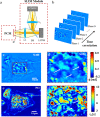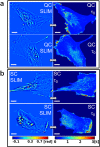Phase correlation imaging of unlabeled cell dynamics
- PMID: 27615512
- PMCID: PMC5018886
- DOI: 10.1038/srep32702
Phase correlation imaging of unlabeled cell dynamics
Abstract
We present phase correlation imaging (PCI) as a novel approach to study cell dynamics in a spatially-resolved manner. PCI relies on quantitative phase imaging time-lapse data and, as such, functions in label-free mode, without the limitations associated with exogenous markers. The correlation time map outputted in PCI informs on the dynamics of the intracellular mass transport. Specifically, we show that PCI can extract quantitatively the diffusion coefficient map associated with live cells, as well as standard Brownian particles. Due to its high sensitivity to mass transport, PCI can be applied to studying the integrity of actin polymerization dynamics. Our results indicate that the cyto-D treatment blocking the actin polymerization has a dominant effect at the large spatial scales, in the region surrounding the cell. We found that PCI can distinguish between senescent and quiescent cells, which is extremely difficult without using specific markers currently. We anticipate that PCI will be used alongside established, fluorescence-based techniques to enable valuable new studies of cell function.
Conflict of interest statement
Gabriel Popescu has financial interest in Phi Optics, Inc., a research instrumentation company that commercializes the SLIM technology.
Figures






References
-
- Alberts B., Wilson J. H. & Hunt T. Molecular biology of the cell. 5th edn, (Garland Science, 2008).
-
- Mofrad M. R. K. & Kamm R. D. Cytoskeletal mechanics: models and measurements. (Cambridge University Press, 2006).
-
- Segev N. Trafficking inside cells: pathways, mechanisms, and regulation. (Landes Bioscience; Springer Science+Business Media, 2009).
Publication types
MeSH terms
Substances
Grants and funding
LinkOut - more resources
Full Text Sources
Other Literature Sources
Molecular Biology Databases
Miscellaneous

